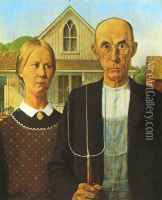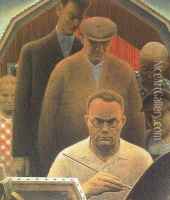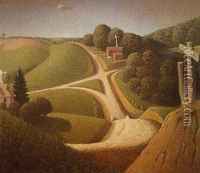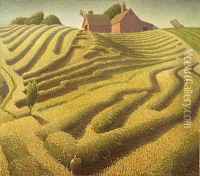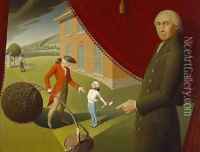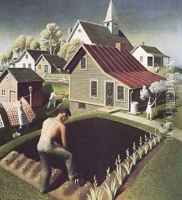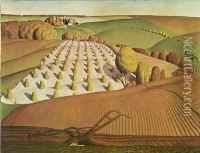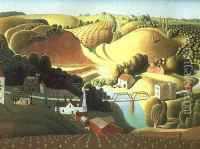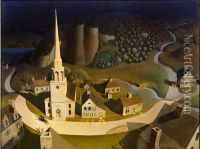Grant Wood Paintings
Grant Wood was an American painter born on February 13, 1891, in Anamosa, Iowa. He is best known for his paintings depicting the rural American Midwest, particularly the painting 'American Gothic,' an iconic image of the 20th century. Wood was educated at the School of the Art Institute of Chicago and served in the army during World War I. After returning from Europe, he taught in a high school and later at the University of Iowa's School of Art.
Wood's early work was influenced by Impressionism, but he shifted towards a more realist approach with a regional focus after traveling to Europe in the 1920s. He was deeply impressed by the Northern Renaissance painters, which is evident in his precise, detailed style, and he sought to create a distinctly American style of art, as seen in his most famous work, 'American Gothic' (1930). The painting shows a farmer and his daughter standing in front of their house and has become a symbol of the American heartland.
Grant Wood was a leading figure in the Regionalist art movement, which emphasized rural American themes and landscapes in reaction to the modernism that was prevalent in the urban centers of Europe and the United States. His work celebrated the virtues of the American Midwest and the integrity of its inhabitants. Wood's paintings often included satirical elements and social commentary, although they were primarily nostalgic and idealistic.
Despite his traditionalist style, Wood's work was not without controversy. Some critics accused him of reinforcing stereotypes, while others saw his work as a critique of the narrow-mindedness and insularity he observed in rural America. Throughout the 1930s, Wood continued to produce significant works, and he became a spokesperson for the Regionalist movement, alongside artists like Thomas Hart Benton and John Steuart Curry.
Grant Wood's health began to decline in the early 1940s, and he was diagnosed with pancreatic cancer. He passed away on February 12, 1942, one day before his 51st birthday, in Iowa City, Iowa. His legacy is that of a quintessentially American artist who captured the essence of his time and place with a unique blend of respect, critique, and affection.
